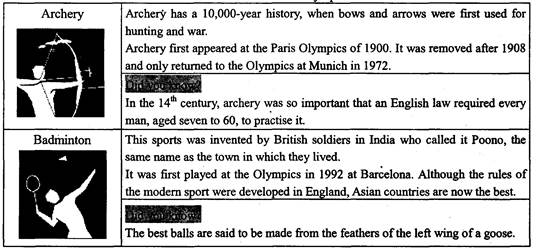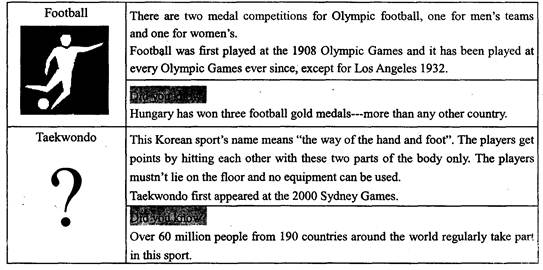网址:http://m.1010jiajiao.com/timu_id_876546[举报]
根据短文内容及首字母提示,填入适当的单词,使短文的意思完整。(在填写答案时,单词的第一个字母要写出来)
Have you ever seen Korean writing before? In many people’s eyes, it 【小题1】l lovely but difficult. Do you know the【小题2】h_________of the special letters?
Long ago, Korean people didn’t 【小题3】o their letters. At that time, they used Chinese characters(字符). Because Chinese is hard to learn, only rich people had the【小题4】m and time to ask teachers to teach them. One of their kings was called Sejong. He decided to【小题5】i_________ Korean Letters. He thought hard.
One day, on 【小题6】O________ 9, 1446, he looked at a window frame(框架)and shouted, “I know what our letters should be!” He was so excited that he cried it loudly. He got the【小题7】i from the frame and invented letters of all the same size. It seemed that they were put in a window frame. The earliest Korean letters were born. King Sejong said, “Chinese characters can’t express Korean meanings. Now I invent 【小题8】o_________ own letters. These letters are very 【小题9】e_________ to learn. I hope that they can help all people learn to read.”
When King Sejong first invented the Korean letters, they had 28 letters, but only 24 are used today. All the Korean people enjoy 【小题10】u their own letters. Some Chinese young people think they’re interesting.
L:Hello, Pan Wei. Is this your new car? How nice!
P:Hi, Lisa. Would you like to go for a ride with me?
L:Great!
P:Well, you don’t have to wear the seat belt(安全带). 1 .
L:I’m sure you are. You know, not all drivers are as good as you.
P: 2 . No one will stop us right now.
L:Oh; no, no. We don’t obey traffic rules for the police. 3
P:I agree, but I feel uncomfortable wearing a seat belt.
L:So do I, a little. 4 You would go flying if your car was hit while you are not wearing a seat belt.
P: 5 I am wearing it. Do you know who invented the seat belt? The man should be remembered.
L:I don’t know. But Volvo, a famous Swedish car maker, was the first to use seat belts in 1849.
| A: That sounds reasonable. B. We obey them for ourselves! C. It taught me a good lesson. D. There are few cars at this time on the road. E.Believe me,I’m an excellent driver. F. And there are no policemen around. G. But the seat belt is for your safety. |
Japan is made up of a chain of islands that lie off the coast of Asia. People came to live in Japan from the nearby countries of China and Korea. From these older countries, the Japanese borrowed ideas, inventions and habits.
For many years, the Japanese built houses like those in China. They dressed themselves like a Chinese. From China came their way of writing and their habit of drinking tea.
In more recent times, the Japanese have borrowed things from our country, the United States. They have a government like ours. They do much work in science, as we do. Baseball is a favorite sport in Japan, just as it is here.
Things change when they come to Japan. The Japanese improve on almost everything they borrow. The art of garden making came from Korea and China, but the Japanese gardens are special. Each garden has a waterfall, a pond, and small bridges. There are few flowers in Japanese gardens. But the gardens are green during all the year round because they have many evergreens. Japanese gardens have a different kind of beauty.
1. The first paragraph of the passage tells us that ________ centuries ago.
A.the Japanese borrowed ideas only from China and Korea
B.people came to live in Japan from neighbouring Asian countries
C.Japan is much older than Korea
D.many Japanese came from the United States
2. In the third paragraph of the passage the italic (斜体)words “just as it is here” mean”________”
A.just as it is in the United States
B.just as it is in China
C.just as it is in Japan
D.just as it is in Asia
3. Why did the Japanese change the things they had borrowed?
A.They wanted very much to be different from others.
B.They didn’t like them the way they were.
C.They wanted visitors to like the change.
D.They tried to make them better.
4. From the passage we can see that ________.
A.Japanese gardens are different from those in other countries but not very beautiful
B.Japanese gardens are full of life during all the seasons
C.Japanese gardens are not very big
D.There are many flowers in Japanese gardens
5. Choose a statement from the following sentences that is NOT true.
A.The government of Japan is like that of the United States.
B.People in the United States like playing baseball.
C.The Japanese invented the habit of drinking tea.
D.Japan is made up of many islands.
查看习题详情和答案>>

Tony Buzan’s grades were going down at university. Disappointed with his low marks, he went to the library to find a book on how to use his brain. He was directed to the medical section. Confused, he said to the librarian, “I don’t want to take my brain out, I just want to learn how to use it.” Her reply was simple: “There’s no book on that.”
“I thought to myself,” says Buzan, “if I buy a little radio, I get an instruction manual (说明书). If I buy a microwave, I get an instruction manual. But for the most important machine in the world, no instruction manual?”
Fifty years later, Buzan has become the world’s leading speaker on the brain and learning. In the late 1960s, he invented the mind map, a visual representation of thought processes.
This kind of thinking has become a popular tool for planning, organizing, problem solving, and communicating across the world. He has since authored and co-authored over 100 books that have appeared in more than 30 languages.
“I think in most cases, people use less than 1 percent of their brains,” he says.
But how do you expand this 1 percent? How do you become the best student you can be?
According to Buzan, the answer is simple. You take a section of whatever it is that you are trying to learn, he says, and you read it for its essence (精髓、要素). Then you make a mind map of all the important details. For a truly effective mind map, you start with a colored image in the center of your page. Draw the first image that comes to mind on the topic you are mind mapping. Branch off from your central image and create one of your main ideas. From your main branches draw some sub-branches and from those sub-branches you can draw even more branches. He emphasizes that you should use plenty of images and colors as these help with memory recall and encourage creativity.
By using this visual format (形式), according to Buzan, your mind will begin to make associations that will help you remember more information for longer periods of time.
Buzan believes that traditional note-taking methods, such as lists and summaries, do not stimulate the brain’s recall capacity or ability in the same way. Because of this, students will often find themselves locked away in their rooms for hours, trying hard to memorize separate details. Buzan believes that for a more effective and lasting way of studying, you must first understand how your brain works.
“Everyone is born smart,” he says. “You just have to learn how to learn.”
1.What is the main purpose of the first two paragraphs?
A.To show that Tony Buzan was worried about his study.
B.To invite us to think about the importance of manuals.
C.To prove that the mind map is a useful tool for the brain.
D.To show why Tony Buzan studies the brain and learning.
2.What does the word “stimulate” mean in the passage?
A.Excite. B.Improve. C.Encourage. D.Affect.
3.What can we infer from the passage?
A.If we learn the mind map, we will become the best student.
B.The mind map will help your brain connect separate details.
C.The mind map will be more effective if we put more details in it.
D.We will solve the problem if we make connections between ideas.
4.What is the best title for the passage?
A.How to make the mind map?
B.Is the mind map widely used?
C.Can your memory be mapped?
D.Is the mind map helpful in thinking?
查看习题详情和答案>>
Welcome to the 2012 London Olympic Games!

【小题1】Who invented the sport of badminton?
| A.Indians. | B.British | C.Chinese. | D.Koreans. |
| A.Archery. | B.Badminton. | C.Taekwondo. | D.Football. |
 查看习题详情和答案>>
查看习题详情和答案>>